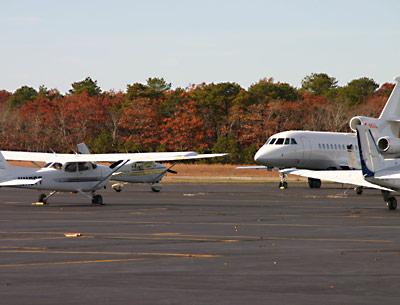Unanimous Vote to Seek F.A.A. Grant

With a unanimous vote on Tuesday, the East Hampton Town Board resolved to apply for a Federal Aviation Administration grant to pay for fencing at East Hampton Airport. The decision followed a standing-room-only hearing last Thursday and prompted an East Hampton attorney, Jeffrey Bragman, to seek an injunction in a Riverhead court yesterday. (A report on the hearing appears below.)
Accepting new federal funds for an airport project will extend, for a new 20-year period, the town’s contractual obligations to the F.A.A., called grant assurances. The board also agreed on Tuesday to initiate a coordinated effort to address the divisive issues surrounding the field, including a study of airport noise, the first step in a procedure that would be necessary in order for the town to petition the F.A.A. for new airport regulations that could curtail noise.
“I tried really hard to balance all legitimate points of view around the airport in a more complex manner than the black-and-white notion of simply not accepting F.A.A. money. In the analysis of financial, safety, noise, and operational issues, I felt a comprehensive proposal had to be developed,” Councilman Dominick Stanzione, who led the town board’s airport deliberations, said yesterday.”I spent the last 18 months pursuing that consensus. As a community we needed to reconcile our differences, taking into consideration the legitimate interests of the entire community.”
“You’ve brought a good plan forward with only one thing in mind — that’s the community,” Supervisor Bill Wilkinson told Mr. Stanzione.
Advocates seeking better control of airport noise — which has grown in scope and intensity as air traffic, particularly helicopters, has increased in a widening area near the airport and across Long Island — had urged the board not to seek the federal dollars, while numerous pilots at last week’s hearing said doing so was a must. Up to 90 percent of the cost of eligible airport projects can be funded by the F.A.A.
Opponents of F.A.A. money believe the ability of the town to institute curfews or other regulations that could effectively control excessive noise would be much greater if the town were free of grant assurances.
Thirty-nine assurances are in place, with the majority to expire in 2021. Enwith the majority to expire in 2021. Enforcement of four of them, however, will end beginning in 2014, according to a legal settlement between the F.A.A. and the Committee to Stop Airport Expansion, a private East Hampton group. That, members of organizations such as the Quiet Skies Coalition have said, will provide an opportunity for the town to make its own decisions.
But overarching federal aviation regulations will remain in place whether the town has contractual obligations to the F.A.A. or not, and there is legal uncertainty about the outcome of a bid to gain local control under either scenario.
“I can tell you the law is uncertain, and where it’s uncertain,” Peter Kirsch, the town’s consulting attorney on airport matters, said on Tuesday. But, he said, “there are things you can do today where the law is quite certain.”
Mr. Bragman said yesterday that the objective of an injunction was to “prevent them from signing a new grant agreement which would block out local control for another 20 years.” He is representing the Committee to Stop Airport Expansion, the same group that challenged the updated airport master and layout plan, which was adopted and submitted to and approved by the F.A.A. after a lengthy procedure begun by a previous town administration.
Along with the vote to apply for F.A.A. funding, the board is in agreement to move ahead concurrently with measures to address airport noise, including a potentially costly F.A.A.-required “part 601” noise study needed for the town to make a case for local noise-reduction reglations even after signing grant assurances.
Mr. Kirsch presented the board with elements of a comprehensive management plan, addressing safety, noise, and operations at the airport, which he has developed with Councilman Stanzione.
The timeline for the plan includes securing a commitment for F.A.A. funding for the fence within 30 days, finalizing a contract to install and operate an air traffic control tower within 15 days, and beginning a formal program to collect noise and safety data within a month.
The plan also calls for developing, within 60 days, a strategy and timetable for specific restrictions on helicopters and starting the formal Part 161 process to request a helicopter curfew within the next six months.
Town Councilman Pete Hammerle, a four-term board member who had served as the airport liaison in prior administrations, congratulated Mr. Stanzione at the Tuesday session. “I think the plan presented today is probably everyone’s best chance of getting immediate relief on helicopter noise — a lot faster than sitting and waiting for grant assurances to run out.” Were the town to do that, he said, conditions at the airport would continue to deteriorate. He said repairs to runway 4-22, now closed because of its unsafe condition, were needed.
“I just hope in the coming year you will continue . . . so that we can grant some relief to the people who are adversely affected,” Mr. Hammerle said to Mr. Stanzione. Mr. Hammerle, who did not run for re-election this year, said, “You’re on a good course here, and I’ve only got two more weeks here, so I hope you’re going to continue.” Should the town successfully complete the Part 161 process and get F.A.A. approval for local regulations, he said, “The question of F.A.A. funding is not an issue.”
